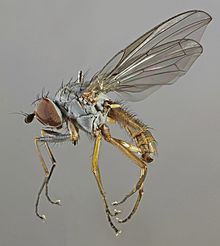You can help expand this article with text translated from the corresponding article in Polish. (March 2024) Click for important translation instructions.
|
| Heteromyza rotundicornis | |
|---|---|

| |
| Heteromyza rotundicornis North Wales | |
| Scientific classification | |
| Domain: | Eukaryota |
| Kingdom: | Animalia |
| Phylum: | Arthropoda |
| Class: | Insecta |
| Order: | Diptera |
| Family: | Heleomyzidae |
| Genus: | Heteromyza |
| Species: | H. rotundicornis |
| Binomial name | |
| Heteromyza rotundicornis (Zetterstedt, 1846) | |
Heteromyza rotundicornis is a species of fly in the family Heleomyzidae. It is found in the Palearctic .
The body length of 4 to 5.5 mm. The head is characterized by the presence of both hairs and setae on the genae , and in males it is also characterized by a gradually truncated frons, wider in the middle than the face . The thorax is characterized by well-developed presutural dorsocenral setae , the presence of setae on the propleura and a naked prothorax . The wings have long pterostigma and spine-like setae on the costa that are longer than the hairs. The middle pair of legs has one well-developed spur on the tibiae.For terms see Morphology of Diptera. Heteromyza rotundicornis is known from Ireland, Great Britain, Belgium, the Netherlands, Germany, Denmark, Norway, Sweden, Finland, Switzerland, Austria, Poland, the Czech Republic, Slovakia, Hungary and Croatia
Content in this edit is translated from the existing Polish Misplaced Pages article at pl:Heteromyza rotundicornis; see its history for attribution
References
- Fauna Europaea
- Bei-Bienko, G.Y. & Steyskal, G.C. (1988) Keys to the Insects of the European Part of the USSR, Volume V: Diptera and Siphonaptera, Parts I, II. Amerind Publishing Co., New Delhi. ISBN 81-205-0080-6 ISBN 81-205-0081-4
- Séguy, E. (1934) Diptères: Brachycères. II. Muscidae acalypterae, Scatophagidae. Paris: Éditions Faune de France 28 Bibliotheque Virtuelle Numerique pdf
| Taxon identifiers | |
|---|---|
| Heteromyza rotundicornis | |
This article related to members of the fly family Heleomyzidae is a stub. You can help Misplaced Pages by expanding it. |